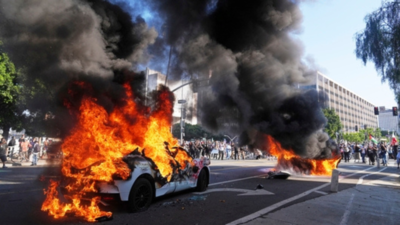ARTICLE AD BOX

Several Waymo self-driving taxis were vandalised and set alight during tense protests in Los Angeles following a wave of immigration raids. While the demonstrations were not specifically aimed at Waymo, the Alphabet-owned robotaxis became targets amid growing anger towards law enforcement, surveillance, and perceived inequality driven by Big Tech.Waymos caught in the chaosAt least five Waymo vehicles, all Jaguar I-PACE electric SUVs, were destroyed during protests over the weekend. Thick plumes of smoke billowed over downtown LA after demonstrators smashed windows, spray-painted anti-ICE slogans, and set the driverless cars on fire. Some protesters reportedly threw electric scooters into the burning shells, while others ripped off car doors or used skateboards and improvised flamethrowers to damage the vehicles.The scenes unfolded on Los Angeles Street between Arcadia and Alameda around 5 pm on Sunday. According to CNN and the Los Angeles Times, the vehicles were found lined up and were soon overwhelmed by a crowd angry over the Trump administration’s decision to send in the National Guard, a move California governor Gavin Newsom opposed.Not just about immigrationWaymo insists the protests were not directly related to its operations. However, critics argue that the robotaxis represent more than just technology.
They say the cars, equipped with dozens of cameras, function as roving surveillance devices and may pose a threat to protester anonymity.“Safety is our highest priority,” Waymo spokesperson Ethan Teicher said in a statement. “We removed vehicles from Downtown Los Angeles and will not be serving that specific area for the time being, out of an abundance of caution and with guidance from LAPD.”A spokesperson told USA Today that the company is still operational across most of Los Angeles but has paused services in certain areas where protests have intensified.Robotaxis: Vulnerable in unrestWaymo’s driverless vehicles, unlike human-operated taxis, lack the ability to judge and flee dangerous situations. Their programmed behaviour makes them passive targets during public unrest. They do not attempt to evade crowds or protest zones. This vulnerability, combined with their high-tech appearance, has made them stand out.The company’s rapid expansion has also drawn criticism. In January, Waymo said it had completed 1.9 million miles in LA alone.
While the cars are popular with many users, some residents feel they were never consulted about having driverless technology tested in their neighbourhoods.Fire risks and health concernsThe destruction of electric vehicles raised significant safety issues. The Los Angeles Fire Department responded to the blazes, and the LAPD warned that burning lithium-ion batteries release toxic gases, such as hydrogen fluoride, which pose risks to both emergency responders and bystanders.Electric vehicle fires are harder to extinguish. Unlike petrol-fuelled cars, EV batteries do not need oxygen to burn. Firefighters instead have to cool the battery using large volumes of water, often through special nozzles that spray directly beneath the vehicle.



.png)
.png)
.png)
















 5 hours ago
4
5 hours ago
4









 English (US) ·
English (US) ·